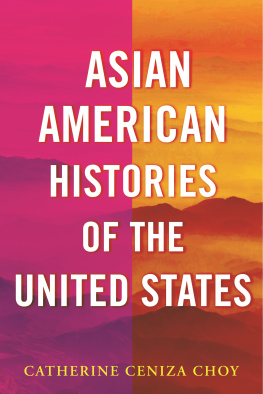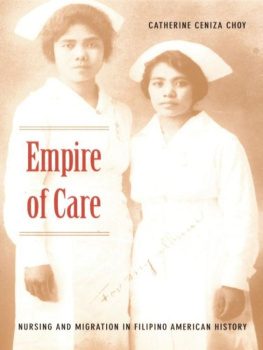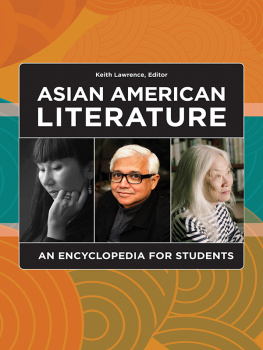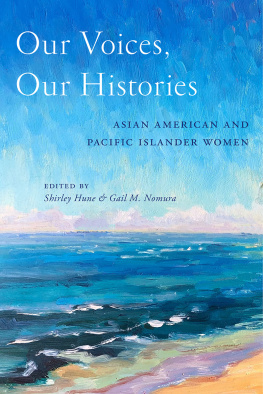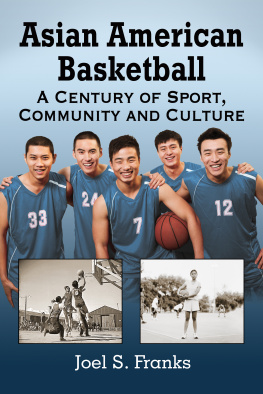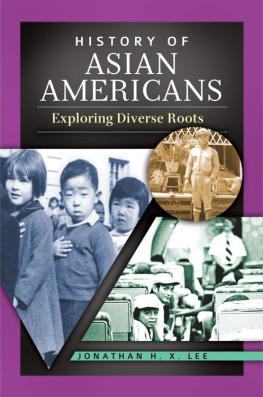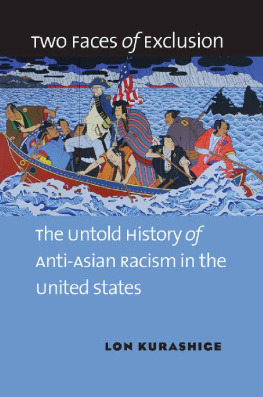Catherine Ceniza Choy - Asian American Histories of the United States
Here you can read online Catherine Ceniza Choy - Asian American Histories of the United States full text of the book (entire story) in english for free. Download pdf and epub, get meaning, cover and reviews about this ebook. year: 2022, publisher: Beacon Press, genre: History. Description of the work, (preface) as well as reviews are available. Best literature library LitArk.com created for fans of good reading and offers a wide selection of genres:
Romance novel
Science fiction
Adventure
Detective
Science
History
Home and family
Prose
Art
Politics
Computer
Non-fiction
Religion
Business
Children
Humor
Choose a favorite category and find really read worthwhile books. Enjoy immersion in the world of imagination, feel the emotions of the characters or learn something new for yourself, make an fascinating discovery.
- Book:Asian American Histories of the United States
- Author:
- Publisher:Beacon Press
- Genre:
- Year:2022
- Rating:4 / 5
- Favourites:Add to favourites
- Your mark:
- 80
- 1
- 2
- 3
- 4
- 5
Asian American Histories of the United States: summary, description and annotation
We offer to read an annotation, description, summary or preface (depends on what the author of the book "Asian American Histories of the United States" wrote himself). If you haven't found the necessary information about the book — write in the comments, we will try to find it.
Asian American Histories of the United States — read online for free the complete book (whole text) full work
Below is the text of the book, divided by pages. System saving the place of the last page read, allows you to conveniently read the book "Asian American Histories of the United States" online for free, without having to search again every time where you left off. Put a bookmark, and you can go to the page where you finished reading at any time.
Font size:
Interval:
Bookmark:


TO

my husband, Greg Choy,
and our children, Maya and Louis,
with love always
Writing in the Years of Great Hatred
I write this book with a sense of personal urgency. Given the long-standing presence of Asian Americans in the United States, how is it that we find ourselves in the years, 2020 and 2021, in the midst of so much hate directed against us?
Throughout 2020, and most notably beginning in March when COVID-19 became a pandemic, anti-Asian, coronavirus-related racism was on the rise. It took shape in various forms of verbal and physical harassment, from bullying Asian American youth and spitting on Asian Americans to blaming us for the disease. This anti-Asian hostility also led to grave violence, such as the knife attack on a Burmese American family in Midland, Texas. The perpetrator blamed the family for spreading the coronavirus.
As I write this in 2021, anti-Asian violence is all around us from New York City to Atlanta to Glendale, Arizona, to the San Francisco Bay Area. We bear witness to some of this violence in video clips shared on social media of Asian American elders just going about their day, taking a walk for some daily exercise or running an errand at a grocery, and suddenly being assaulted, knocked to the ground, punched in the face, dragged from a car in a purse-snatching gone awry. On March 29, Vilma Kari, a sixty-five-year-old Filipino woman who had emigrated from the Philippines decades ago, was brutally attacked in broad daylight in front of a luxury building in Manhattan.
Some of these assaults have been fatal. After being pushed with a level of force that knocked him to the ground, eighty-four-year-old Thai immigrant Vicha Ratanapakdee never regained consciousness and passed away two days later.
This anti-Asian violence is about misogyny as well as racism. Asian American women make up a disproportionate share of these attacks.
Its not solely the brute violence that plays out in my mind. In Juanito Falcon, I see my Lolo, my Filipino grandfather. In Vilma Kari, I see my Filipino mother walking on her way to church. I learn that this violence is also playing out in the minds of my own children. And that, in the victims of these attacks, they see me.
My son, who is away at college, calls my husband and me. Are you okay? he asks. Hes seen the videos and news stories of this violence. He fears what I fear. For most of 2020 and in the first few months of 2021, it is as though it has been open season to harass and harm Asian Americans. As though we are less than human, our lives expendable.
This fear threatens in ways both internal as well as external. It creates tension in your head, it hurts your heart. Your thoughts race. Will I or one of my family members be next? What will I do if it happens to me? Why is this happening?
As an Asian American historian who has researched, written, and taught Asian American history for over two decades, I know that so much of what I am observing and we are experiencing in these times is not new. Anti-Asian violence in the United States has a history that spans over 150 years. So too does the objectification of Asian women, as does the association of Asian bodies with disease. That Asian American history may still seem like an unknown quantitywell, that has a history too.
Asian American historical scholarship and teaching have made incredible strides over the past three decades, most notably in US university and college departments and programs, book publishing, and academic professional organizations. Yet, despite this progress, a profound lack of understanding of Asian American history permeates our culture.
This lack of understanding has led to a misunderstanding of Asian Americans and our histories. Instead, generalizations about who we are pass for common knowledge. Asian Americans are whiz kids, innately good at math and memorization. As adults, Asian Americans are model minorities who do not complain. Asian American men are effeminate or asexual while Asian American women are exotic and alluring. All Asian Americans are successful.
Some might ask, what could be wrong with this? After all, arent there stereotypes of every group of people and culture? And isnt much of this the most positive branding a group could hope for?
Whats problematic about this misunderstanding is that it contributes to the dehumanization of Asian Americans. These one-dimensional depictions, even the seemingly positive ones, can turn sinister in an instant, comprising two sides of the same coin that can easily be flipped. Thus, Asian Americans may be considered model minorities at one moment, but then quickly transform into something menacing. An Asian American woman is a lotus blossom, but also a dragon lady. Both are attractive, but the dragon lady is a villainess.
I painfully observed this fine line between docility and danger during the research for my first book, Empire of Care, about Filipino nurses in the US. In the 1960s and 1970s, tens of thousands of Filipino nurses immigrated to the United States to alleviate critical nursing shortages.
Thus, this duality of being superhuman (e.g., the whiz kid, model minority) and of being subhuman (e.g., spreaders of the China virus, dirty Japs, and slant-eyed bitches, as one witness referred to Narciso and Perez) has a history. Its endgame is to objectify Asian Americans as non-Americans and even non-human. Tragically, in times of crises, such as disease outbreaks and economic downturns, dehumanization lends itself to racial, classed, gendered, and sexualized scapegoating and the surge of anti-Asian violence that we bore witness to in 2020 and 2021.
This misunderstanding is in large part a legacy of the American past. Historically, Asian identity was set in opposition to the American one in an expanding cascade of so many national, state, and local laws. Nineteenth- and early twentieth-century immigration laws, such as the 1882 Chinese Exclusion Act and the 1917 Immigration Act, which created the Asiatic Barred Zone, literally attempted to keep Asians out of the United States. US Supreme Court cases, such as Takao Ozawa v. United States in 1922 and the United States v. Bhagat Singh Thind in 1923, rendered Japanese and Indian immigrants ineligible for US citizenship because they were non-white. Alien land laws in California then barred persons ineligible for US citizenship from owning land. Anti-miscegenation laws in Arizona, Nevada, Oregon, Utah, and other states prohibited interracial marriage between Asians and whites.
American popular culture played a formative role in portraying Asians as subhuman and superhuman threats. In the late nineteenth and early twentieth centuries, worlds fairs and political cartoons disseminated ideas of Asians as uncivilized children in need of American tutelage, threatening hordes, and harbingers of disease and immorality. During the Golden Age of Hollywood, producers profited from featuring Asians as mystical evildoers intent on taking over the Western world.
This positioning of Asians in opposition to American identity and experience is perhaps most powerfully expressed through the erasure of their long-standing presence in the United States and their contributions to its various industries. When Asians in the United States contributed to the building of the nation through railroad construction, agricultural development, military service, and labor organizing, many of these contributions were erased or forgotten. One egregious, early historical example is the omission of Chinese railroad workers in the iconic photograph of the ceremony that marked the completion of the transcontinental railroad in 1869, even though they built half of it. Another is the historical record overlooking the leadership of Filipino American Larry Itliong in the United Farm Workers, and the sacrifices of many other Filipino American organizers in US labor history.
Font size:
Interval:
Bookmark:
Similar books «Asian American Histories of the United States»
Look at similar books to Asian American Histories of the United States. We have selected literature similar in name and meaning in the hope of providing readers with more options to find new, interesting, not yet read works.
Discussion, reviews of the book Asian American Histories of the United States and just readers' own opinions. Leave your comments, write what you think about the work, its meaning or the main characters. Specify what exactly you liked and what you didn't like, and why you think so.

